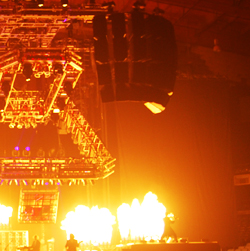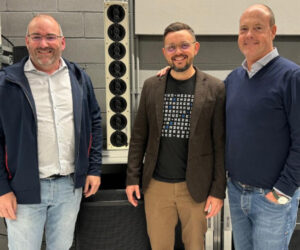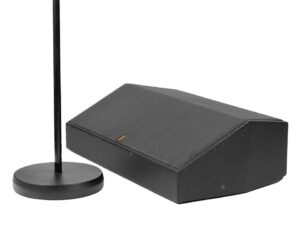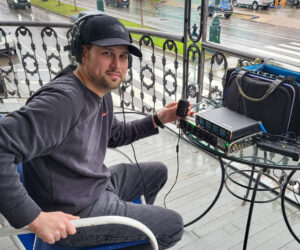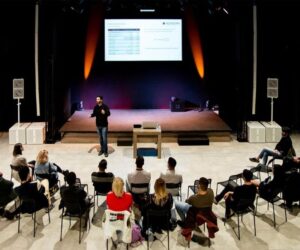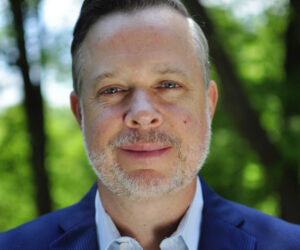Not since the legendary Burl Ives sang and narrated the animated Rankin-Bass television special Rudolph The Red-Nosed Reindeer (1964) has there been such a Christmas phenomenon as Trans-Siberian Orchestra (TSO).
A late load-in had the crew scrambling at 11 a.m. at the Allstate Arena in Chicago, and with the doors were opening at 3 p.m. for a matinee show, it was their next-to-last date for TSO’s East tour production for the 2008 season.
TSO uses identical systems on both East Coast and West Coast touring productions, where they deploy old-school practicality with new-school technology.
Todd Johnson, Director of Touring at Clair’s Chicago location, has been with TSO since their touring inception, and he oversees the pro audio side from rehearsals to the last show of the season.
Walking through the arena, Johnson began to give a little background on the audio side of TSO’s growth. The first year was the beginning for Johnson.
“I believe we did four cities – Chicago, Cleveland, New York and Philadelphia – seven shows total,” he said. “I’m very involved, working closely with Dave Wittman (Head of Audio) and the production managers Patrick Whitley and Jeff Boguski to insure we get the most out of everything… sonic quality, truck space, coverage and sight lines, etc.
“Also, Elliot Saltzman (Tour Director) keeps a very close eye on what we do in the decision making process.”
Over the last 10 years of tours, Johnson says changes have been minimal. “We use the same loudspeaker system, but it just keeps getting bigger. When we started, the band used all wedges and now the band is 50/50 ears and wedges.”
All audio is overseen by Paul O’Neil (TSO’s Composer, Lyricist and Producer). The buck stops with O’Neil. He likes having both East and West Coast touring productions using the same gear to try to keep the shows as consistent as possible.
Traditional Front Of House Mixing
Front of House Engineer Dave Wittman started his career as an intern at Electric Ladyland Studios working with world-renown Producer Eddie Kramer in 1972. Wittman worked on the demo that got Kiss its first record deal, and went on to engineer a slew of Kiss albums. He worked on studio projects that made rock ‘n’ roll history as we know it today.
After the matinee show in Chicago, Wittman sat down in a cold dressing room to talk about his 10-year tenure with TSO. “We’ve been using a Midas Heritage 3000. The running joke now is that we’ve been thinking about switching to a digital console because I’m running out of inputs. I’m putting more stereo inputs in the slots in the Heritage.
“As a studio guy, I still want to have the stereo thing. I’d still like to have access to the faders at one time rather than do the paging thing. I’m sure I can set up my system for whatever I need to do. I was dragged kicking and screaming into digital recording as well, switching from tape to hard drive but I worked a little bit with a Yamaha digital console in the studio so it’s certainly a feasible thing for me. I like the sound of the Midas and I like having everything in front of me.”
The tour features an Electro-Voice X-Array loudspeaker system, which Wittman explains they selected when the tour first started a decade ago. “I have read a lot about line arrays, and we’re certainly looking at them as an option,” he states.
Wittman loves venues with inborn ambiance, which explains the minimalist old school approach to his mixing. He says, “When the natural acoustics of the venue sound great, it just pumps me up.”
For outboard equipment, he simply uses his Heritage, explaining, “It’s very minimal – just like in the studio. I prefer Lexicon reverbs, this time using a PCM 80 and PCM 90. I just like the rich chamber sound, which I can add in small amounts in the ‘drier’ rooms, but nothing over the top!” He also uses an Eventide H3000 harmonizer.
It works unbelievably well. Like the old saying goes, “It’s not the gear, it’s the ear.” There is no outboard EQ at all, just dbx 160’s for vocals, bass, lead guitar and piano. Everything else is notched in off the Midas.
System Engineer Michihiro (Michi) Tanakwa handles the business of deploying the entire system. Wittman gives credit where it is deserved. “Michi is the best. He knows this system like the back of his hand and there is no way we could do without him. He will catch a problem even before it occurs. He’s that good. He’s both sharp and attentive!”
Bringing Monitor World Into The Digital Realm
Monitor Engineer Tony Luna has toured with KISS, 3 Doors Down, The Rolling Stones, Matchbox 20, Cheap Trick, Metallica and many others. He loves to talk shop and beams about new technology and ideas. His take on mixing monitors is a real delight as he took a break between shows to sit down on the bus.
“The DiGiCo D5 I’m using is really flexible – I like the way it’s laid out. It works well for me. It’s got two solo buses and I think that’s really important. I’m using 64 inputs and all the outputs of the desk to drive a combination of eight stage mixes of wedges and 13 stereo pairs of in-ears.
“I’m using a whole bunch of different things… Shure UHF-R mics, Sennheiser G2 IEM and PWS combiners with their helical antennas. This year for wedges we’re using Electro-Voice Xw15 with Crown 36 x 12 with P.I.P modules. It’s been interesting mixing over the years – doing the same mix on different manufacturer’s brands. I have a good time using all of them.”
Using all the outputs on the D5 for the monitor side, Luna has a variety of models of in-ears to deal with and the action never stops on a TSO show. “I’ve been using Sensaphonics 2XS and I’ve been mixing on Ultimate Ears UE7’s. My guitar players have been using Ultimate Ears UE11 ambients. I find that when I use the UE7’s, I have a good basis of reality. The 2Xs units sound great for the mixes I’m using those on. I’m using Sensaphonics for the singers. Most of the musicians – with the exception of the keyboard player – are using Ultimate Ears. The drummer is using Sensaphonics – the 2XS.


